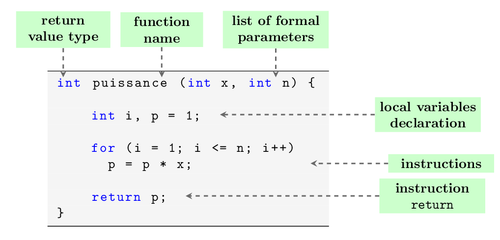This example illustrates the joint use of tikz and listings packages. It represents the anatomy of a C function. Compile twice for correct positioning.

Edit and compile if you like:
% Author: Valeria Borodin
\documentclass[border={35pt 10pt 150pt 60pt}, % left bottom right top
svgnames]{standalone}
\usepackage{tikz}
\usetikzlibrary{positioning}
\usepackage{listings}
\lstset{%
frame = tb, % draw frame at top and bottom of code block
tabsize = 1, % tab space width
numbers = left, % display line numbers on the left
framesep = 3pt, % expand outward
framerule = 0.4pt, % expand outward
commentstyle = \color{Green}, % comment color
keywordstyle = \color{blue}, % keyword color
stringstyle = \color{DarkRed}, % string color
backgroundcolor = \color{WhiteSmoke}, % backgroundcolor color
showstringspaces = false, % do not mark spaces in strings
}
\begin{document}
\begin{lstlisting}[language = C++, numbers = none, escapechar = !,
basicstyle = \ttfamily\bfseries, linewidth = .6\linewidth]
int!
\tikz[remember picture] \node [] (a) {};
!puissance!
\tikz[remember picture] \node [] (b) {};
!(int x,!
\tikz[remember picture] \node [] (c){};
!int n) {
int i, p = 1; !\tikz[remember picture] \node [] (d){};!
for (i = 1; i <= n; i++)
p = p * x; !\tikz[remember picture] \node [inner xsep = 40pt] (e){};!
return p; !
\tikz[remember picture] \node [] (f){};!
}
\end{lstlisting}
\begin{tikzpicture}[remember picture, overlay,
every edge/.append style = { ->, thick, >=stealth,
DimGray, dashed, line width = 1pt },
every node/.append style = { align = center, minimum height = 10pt,
font = \bfseries, fill= green!20},
text width = 2.5cm ]
\node [above left = .75cm and -.75 cm of a,text width = 2.2cm]
(A) {return value type};
\node [right = 0.25cm of A, text width = 1.9cm]
(B) {function name};
\node [right = 0.5cm of B] (C) {list of formal parameters};
\node [right = 4.cm of d] (D) {local variables declaration};
\node [right = 2.cm of e] (E) {instructions};
\node [right = 5.cm of f] (F) {instruction \texttt{\bfseries return}};
\draw (A.south) + (0, 0) coordinate(x1) edge (x1|-a.north);
\draw (B.south) + (0, 0) coordinate(x2) edge (x2|-b.north);
\draw (C.south) + (0, 0) coordinate(x3) edge (x3|-c.north);
\draw (D.west) edge (d.east) ;
\draw (E.west) edge (e.east) ;
\draw (F.west) edge (f.east) ;
\end{tikzpicture}
\end{document}Click to download: tikz-listings.tex • tikz-listings.pdf
Open in Overleaf: tikz-listings.tex


